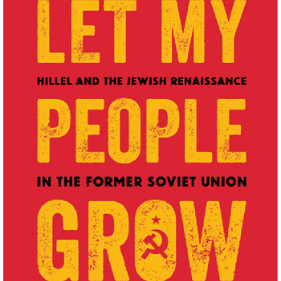Hillel’s ‘Mr. International’ Looks Back on 20 Years of Hillel in the Former Soviet Union

In the early 1990s, as the Iron Curtain fell in Europe, Hebrew University of Jerusalem Hillel Director Yossie Goldman noticed something of a trend—Russian Jews were arriving at the university and joining Hillel in droves. Through conversations with these Russian students, Goldman realized that there were more than 1.5 million Jews who remained in Russia, and he began to reflect on how Hillel could help them seize this newfound opportunity to form a strong Jewish connection.
“That sparked the idea that, perhaps, Hillel could go to the Former Soviet Union (FSU) or Russia and start Hillels there,” he says. “That’s how it all began.”
Goldman’s experience setting up a network of Hillel branches in the FSU is the inspiration for his new book, “Let my People Grow: Hillel and the Jewish Renaissance in the Former Soviet Union,” available now from Gefen Publishing.
While Goldman’s commitment to the work was strong from the outset, bringing Hillel to a region where Judaism was persecuted was no small feat.
For 75 years under Communist rule, Jews were denied basic rights, Goldman says, including the right to openly practice their religion. Most synagogues were closed, and the remaining ones were largely for show. Those who were brave enough to learn about Judaism could be sent to gulags in Siberia.
“So here you are with three generations of Jews who knew nothing about history, about heritage, about their people. The only thing they knew–they knew they were Jews. Why? Because the regime reminded them by putting in the ID card that every Russian had to carry, it said that you were Jewish. That’s all they knew.”
Goldman secured funding to launch the first Hillel in the FSU from the American Jewish Joint Distribution Committee (JDC), a Jewish humanitarian organization, and the Charles and Lynn Schusterman Family Foundation, a global philanthropic organization dedicated to the advancement of equity and justice.
He began by bringing together a group of Jewish students for 10 days to build a Hillel outside of Moscow during the winter of 1996. Building off the enthusiasm students there showed, he started new Hillels in Kiev and St. Petersburg. By 2000, there were 27 Hillels throughout the FSU.
These early efforts were not without setbacks and missteps. Hillel’s model of structuring chapters around universities proved a mismatch for the region’s university system, which organized schools by area of study rather than by geography.
“If you want to study journalism, you went to the university of journalism,” Goldman notes. “If you want to study accounting, you went to the university of accounting.”
Goldman quickly realized there would not be enough funding to set up Hillels at every university, and many students would be left out. So, he and other leaders dreamed up a community-based Hillel model. Hillels would be located near centers of populations like metro stations to attract participants from all around the area. They also implemented a co-location model in places like St. Petersburg and Tbilisi where Hillels shared space with JDC, with buildings used for the elderly during the day, and by Hillel in the evening. Hillels using these two models were also created in Belarus, Moldova, Azerbaijan, and Uzbekistan.
While state-sponsored anti-Semitism officially ended when the Soviet Union fell, Hillel leadership knew they had to hedge against the possibility that the pendulum could swing again, so they prioritized hiring local, indigenous staff who could sustain the community if international professionals were chased out by an unfriendly government. This approach brought added benefits, Goldman says.
“Local people know their own community, their own culture, the needs of their community, and that will work best.”
To get a sense of the movement’s impact, Goldman looks to the success of alumni from the 1990s and 2000s, whose achievements range from becoming the Deputy Mayor of Odessa, Ukraine to staffing the World Bank. Moreover, the community Hillel model has sparked new Hillel movements in France, Germany, Hungary, and other countries.
Somewhere along the way, Goldman, who dubs himself Hillel’s ‘Mr. International’ went on to become the Director of Global Expansion for Hillel International, a position he held for many years before moving on to other ventures.
“For history’s sake, people should realize the contribution Hillel made toward the renaissance of Jewish life in the former Soviet Union,” Goldman says. His book, “Let My People Grow,” tells that story, and is already making waves in the Jewish media. “Literally thousands of young people and tens of thousands of their family members were connected to Jewish life, to the Jewish people through Hillel. This was a game changer.”